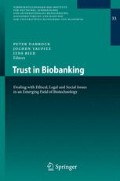Abstract
The collection of tissue samples has become a valuable basis for medical research. Relying on a deeply rooted tradition in cancer research, a common biobank project has been established in Heidelberg within the “National Center for Tumor Diseases” (NCT). As there is a lack of specific legal regulation in Germany, organisational requirements are uncertain. The use of a one-time general informed consent procedure containing both oral and written elements, attended by a physician, should guarantee the utmost legal security and respect for ethical considerations. The project is also mentioned in the hospital treatment contract. As the idea of ‘informed consent’ has become indispensable to medical ethics it is questionable whether, under well-defined circumstances, it might nevertheless be replaceable by regulatory means. Given the experience of the ‘NCT Tissue Bank’ that not a single patient refused to donate leftover tissue for subsequent use, a procedure based on contradiction might be regarded as more appropriate. In addition to ethical and legal considerations, the perspectives of those directly involved should be appreciated. We asked our patients, therefore, for their opinions as to whether the established informed consent procedure is satisfactory or in any way deficient.
Access this chapter
Tax calculation will be finalised at checkout
Purchases are for personal use only
Preview
Unable to display preview. Download preview PDF.
Literatur
Barr M (2006) ’I’m not really read up on genetics’: biobanks and the social context of informed consent. BioSocieties 1: 251-262
van Diest PJ (2002) No consent should be needed for using leftover body material for scientific purposes. For. BMJ 325: 648-649
Furness PN (2006) One-time general consent for research on biological samples: good idea, but will it happen? BMJ 332: 665
Godard B, Schmidtke J, Cassiman JJ et al (2003) Data storage and DNA banking for biomedical research: informed consent, confidentiality, quality issues, ownership, return of benefits. A professional perspective. Eur J Hum Genet 11: 88-122
Harris J (2005) Scientific research is a moral duty. J Med Ethics 31: 242-248
Jack AL, Womack C (2003) Why surgical patients do not donate tissue for commercial research:review of records. BMJ 327: 262
Malone T, Catalano PJ, O’Dwyer PJ et al. (2002) High rate of consent to bank biologic samples for future research: the Eastern Cooperative Oncology Group experience. J Natl Cancer Inst 94: 769-771
Moutel G, de Montgolfier S, Meningaud JP et al (2001) Bio-libraries and DNA storage: assessment of patient perception of information. Med Law 20: 193-204
Savulescu J (2002) No consent should be needed for using leftover body material for scientific purposes. Against. BMJ 325: 649-651
Start RD, Brown W, Bryant R et al (1996) Ownership and uses of human tissue: does the Nuffield bioethics report accord with opinion of surgical inpatients? BMJ 313: 1366-1368
Taupitz J, Wicklein M (2007) Biobanken: Spannungsfeld zwischen Forschung und Persönlichkeitsschutz. BioFokus 74: 3-7
Wendler D (2006) One-time general consent for research on biological samples. BMJ 332: 544-547
Wheeler J, Agarwal M, Sugden J et al (2007) Experiences from the front-line routine consenting of surplus surgically removed tissue: without investment by the National Health Service fully informed consent for all is not available. J Clin Pathol 60: 351-354
Zigmond AS, Snaith RP (1983) The hospital anxiety and depression scale. Acta Psychiatr Scand 67: 361-370
Author information
Authors and Affiliations
Editor information
Editors and Affiliations
Rights and permissions
Copyright information
© 2012 Springer-Verlag Berlin Heidelberg
About this paper
Cite this paper
Huber, J., Herpel, E., Autschbach, F., Buse, S., Hohenfellner, M. (2012). Collection of Biospecimen Resources for Cancer Research. In: Dabrock, P., Taupitz, J., Ried, J. (eds) Trust in Biobanking. Veröffentlichungen des Instituts für Deutsches, Europäisches und Internationales Medizinrecht, Gesundheitsrecht und Bioethik der Universitäten Heidelberg und Mannheim, vol 33. Springer, Berlin, Heidelberg. https://doi.org/10.1007/978-3-540-78845-4_6
Download citation
DOI: https://doi.org/10.1007/978-3-540-78845-4_6
Published:
Publisher Name: Springer, Berlin, Heidelberg
Print ISBN: 978-3-540-78844-7
Online ISBN: 978-3-540-78845-4
eBook Packages: Humanities, Social Sciences and LawLaw and Criminology (R0)

